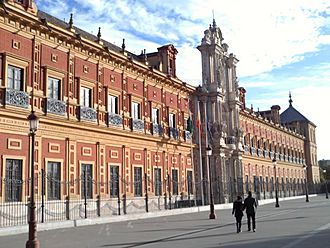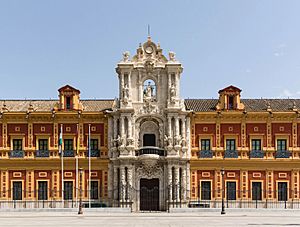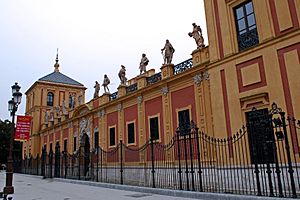Palacio de San Telmo facts for kids
Quick facts for kids Palace of San Telmo |
|
|---|---|
|
Palacio de San Telmo (Spanish)
|
|

General view of the Palace of San Telmo.
|
|
| General information | |
| Architectural style | Spanish Baroque |
| Location | Seville, Spain |
| Design and construction | |
| Architect | Leonardo de Figueroa |
| Official name: Palacio de San Telmo con el Jardín contiguo al mismo | |
| Type: | Non-movable |
| Criteria: | Monument |
| Designated: | 6 April 1968 |
| Reference #: | RI-51-0007309 |
The Palace of San Telmo (Spanish: Palacio de San Telmo) is a historic building in Seville, southern Spain. It used to be a special school for sailors called the Universidad de Mareantes. Today, it's where the leader of the Andalusian Autonomous Government works. This government manages the region of Andalusia in Spain.
Building the palace started in 1682. It was built outside the city walls on land that belonged to a powerful religious group. The palace was first made to be the home of the University of Navigators. This school taught orphaned children and trained them to become sailors.
Contents
Discovering the Palace of San Telmo
The Palace of San Telmo is one of the most famous buildings in Seville that shows off Baroque architecture. Baroque is a fancy and detailed style of building that was popular a long time ago.
The palace has a rectangular shape. It has several courtyards inside, including a main one. There are also towers at each of its four corners, a chapel, and beautiful gardens.
The Palace Chapel
The chapel inside the palace is very ornate and detailed, typical of the Baroque style. It was designed by the architect Leonardo de Figueroa. Many talented artists helped decorate it, including the sculptor Pedro Duque y Cornejo and the painter Domingo Martínez. Inside the chapel, you can see an old statue from the early 1600s of "Our Lady of Good Air."
Outside the Palace: Amazing Details
The main front of the palace is known for its grand entrance, which was finished in 1754. This entrance was made by other members of the Figueroa family, Matías and Antonio Matías, who were the son and grandson of Leonardo de Figueroa.
The entrance has many parts. The main door is surrounded by three columns on each side. Above the door, there's a balcony held up by statues of men called Atlantes. You can also see twelve statues of women that represent different skills and sciences related to sailing. At the very top, there's a group of sculptures with columns and a statue of Peter González, also known as Saint Telmo. He is the patron saint (a special protector) of sailors. On either side of him are statues of Saint Ferdinand and Saint Hermenegild, who are the patron saints of Seville.
On the side of the palace that faces Calle Palos de la Frontera, there are twelve statues of famous people from Seville. These statues were made in 1895 by Antonio Susillo. Some of these important figures include:
- Juan Martínez Montañés, a famous sculptor.
- Diego Rodríguez de Silva y Velázquez, a well-known painter.
- Miguel Mañara, a kind person who started a hospital in Seville.
- Bartolomé Esteban Murillo, another famous painter.
- Bartolomé de las Casas, a monk and bishop who protected the native people in Mexico.
It's interesting to know that three of these famous people weren't born in Seville but lived and died there.
The palace gardens once included a unique building called the Queen's sewing box (Costurero de la Reina). This small, castle-like building was built in 1893 and is now located in the Parque de María Luisa. It is the oldest building in Seville made in the neomudéjar style, which is a mix of old Spanish and Islamic designs.
History of the Palace
The construction of the Palace of San Telmo began on March 10, 1682. It was first used as the University of Navigators, a school that later changed its name to Colegio de Marina and then Colegio de Naútica. It served as a school until 1847.
After that, the building was used for different things. For a short time, it was the office for a railway company and a literary university. However, these groups couldn't afford to keep up the large building.
In 1849, the palace was bought by Antoine, Duke of Montpensier. He was a son of King Louis Philippe of France and had to leave France after the revolutions of 1848. He and his wife made the palace their home. When Infanta Luisa Fernanda, Duchess of Montpensier passed away in 1897, she left the palace to the Archdiocese of Seville. She also gave the palace gardens to the city of Seville. These gardens are now part of the beautiful Parque de María Luisa, which was a site for the Ibero-American Exposition of 1929.
In 1901, the palace became a seminary, a school for training priests. It remained a seminary until 1989. Then, the Archdiocese of Seville gave the building to the Andalusian Autonomous Government. This made the palace the new official home for the leader of the region.
Restoring the Palace
In 1991, work began to prepare the palace for its new role as the official seat of the Andalusian Autonomous Government. More restoration work happened in 2005. This focused on fixing up parts of the palace that were built in the 1700s and 1800s. They also improved parts that were added in the 1900s but were not very well made.
See also
 In Spanish: Palacio de San Telmo para niños
In Spanish: Palacio de San Telmo para niños






